Kim Eichler-Messmer is a textile artist living and working in Kansas City. Born in Iowa as an only child to two hard-working and creative parents, Kim developed a love of art from an early age. In college, she discovered a passion for working with textiles, and almost all of her quilts are hand dyed. Since 2008, Kim has been an Associate Professor in Fiber at the Kansas City Art Institute, where she has taught surface design, quilting, and natural dye. She received an MFA in Textiles from the University of Kansas and a BFA in Drawing and Printmaking from Iowa State University. Her hand dyed, one-of-a-kind quilts have been exhibited nationally in numerous solo and juried shows and featured on prominent design blogs including Apartment Therapy and Design Sponge. Kim is the author of Modern Color: An Illustrated Guide to Dyeing Fabric for Modern Quilts and her work has been featured in many books and publications, including: Quilting with a Modern Slant by Rachel May; The Essential Guide To Modern Quilt Making, edited by Heather Grant; and The Uppercase Compendium of Craft and Creativity by Janine Vangool. Most recently, Kim has been exploring natural dyes and dying techniques. This summer, she traveled to Japan, where she studied with shibori masters. She also taught a summer workshop for the Penland School of Crafts, in Penland, North Carolina on natural dyes and quilting. Welcome, Kim!
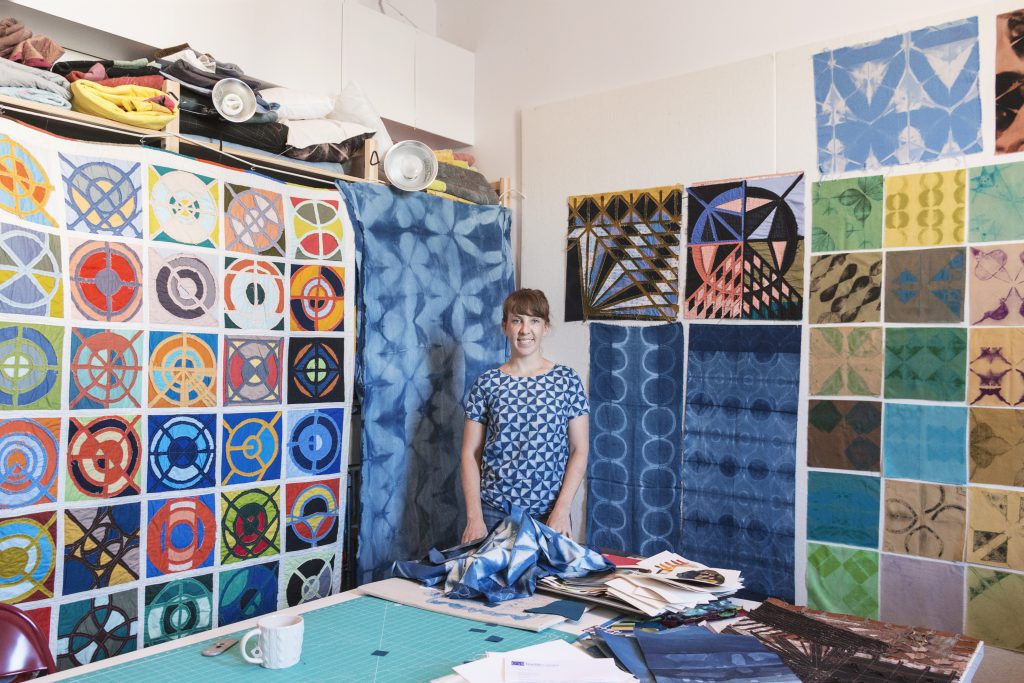 How would you describe your quilting style/aesthetic?
How would you describe your quilting style/aesthetic?
Kim: I’m very influenced by place and landscape. I have lived most of my life in the Midwest, but have travelled pretty extensively. Abstracted views of landscape often find their way into my work, as do the use of light and color to represent time and seasons. I like to combine loose improvisation with planned structure. I have been hand dyeing fabric longer than I have been a quilter, so my work always includes a majority of hand dyed fabrics, which I think gives the work a distinct feel. My hand dyed fabric tends to be a mottled kind of solid, which adds depth and texture to my quilts.
My aesthetic really seems to change every few years depending on what I’m curious about at the time. As a teacher, I get the benefit of having really smart students who ask great questions, and because of this I’m constantly learning and testing new ways of dyeing fabric and making quilts, which then find their way into my own work.
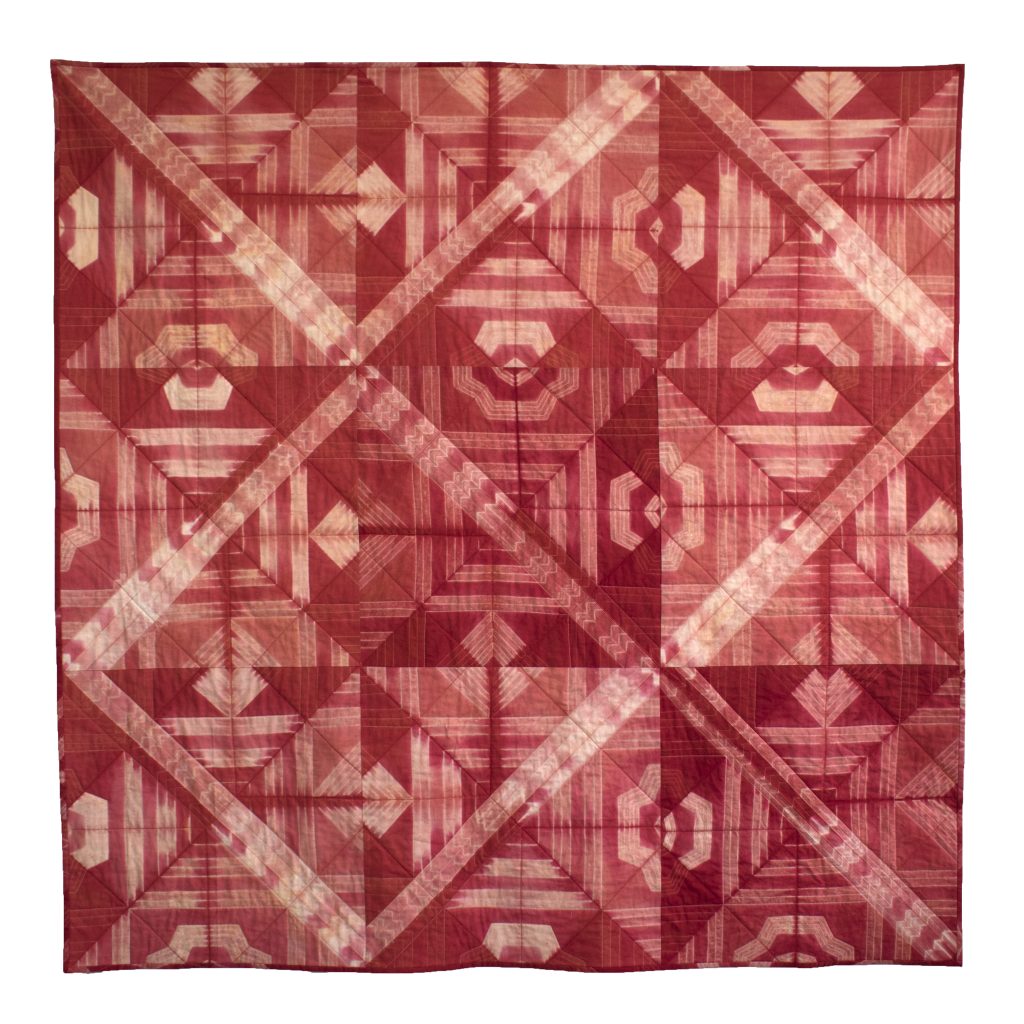
Pathways. Image courtesy of Kim Eichler-Messmer.
How would you describe the creative environment in your home as a child?
Both of my parents were creative growing up. My mom ran a stained glass shop and studio in our basement and my dad was a woodworker who made wooden wall hangings and boxes with inlaid wood quilt designs. They both sold their work at art fairs and local galleries. They would sometimes let me help choose patterns or colors for projects and I got to help them set up their booths at the art fairs. It was a pretty major part of our lives for a while. I’m so grateful for it now, because I saw how hard they worked, but also how fulfilling it was. They also encouraged me to be creative. As an introverted only child, I spent a lot of time drawing, painting, weaving on a little frame loom, and making various crafts. My mom enrolled me in summer art camps and I took art classes all through high school. My dad was also a great cook and loved trying new recipes. He taught me both how to sew and how to cook. I remember when I lived by myself for the first time, I would often call him and tell him the limited number of items I had in my refrigerator and he would help me figure out what to cook for dinner.
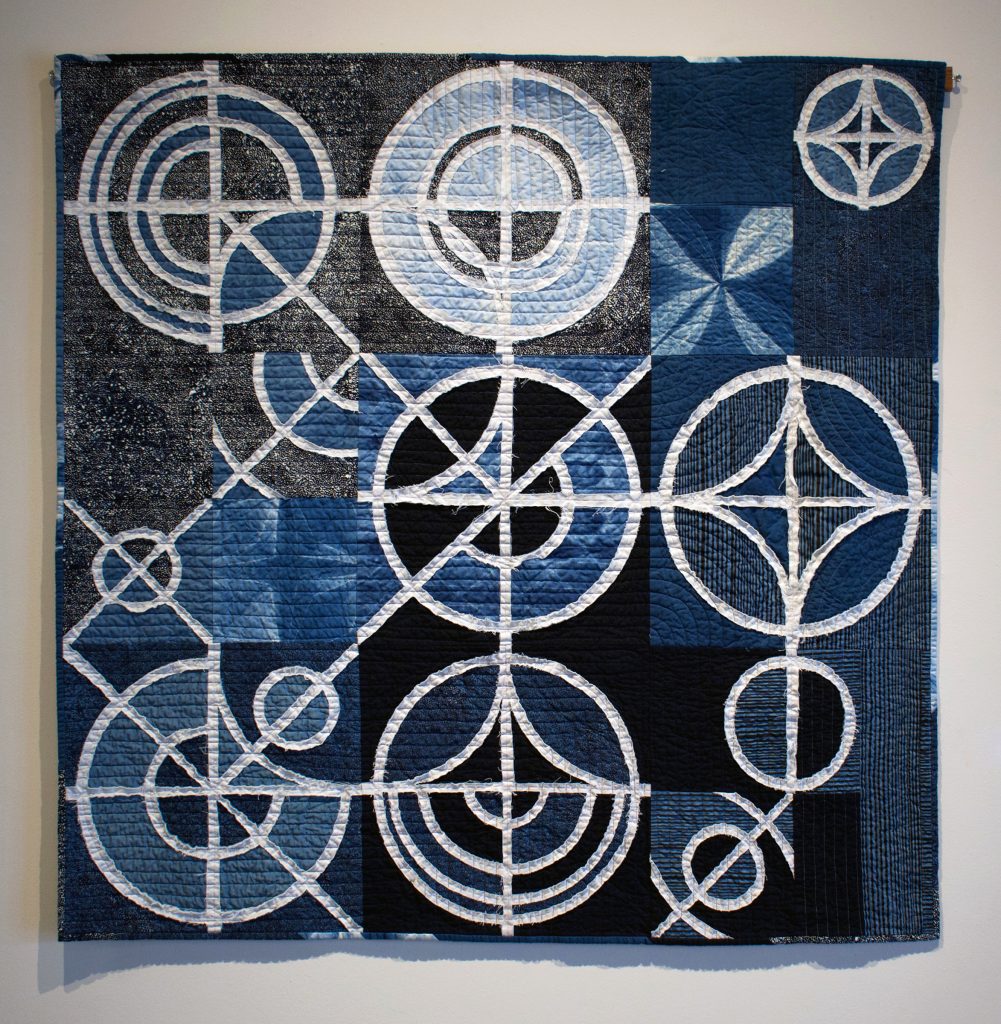
Fulcrum. Image courtesy of Kim Eichler-Messmer.
What artists and makers do you most admire or have an influence on your work?
Lucienne Day and Sonia Delaunay are two of my all-time favorites. They both made work that felt so loose, expressive, and full of joy and color. Sonia Delaunay’s work really resonated with me when I was in college, because she worked between painting and textiles. I did a lot of painting and printmaking when I was pursuing my BFA, but always loved sewing. When I first saw her work, I finally realized that there didn’t have to be a hierarchy in art. Sewing and textiles were just as valid as painting.
In Lucienne Day’s work, there were often quirky, hand-drawn looking elements that added such spirit to the fabric. She was really important in post-WW2 England, and I love that one of her main goals in making work was to bring joy back into people’s homes. Her silk mosaics are also to die for. I love it when people question the “rules” of quilts. Who cares if there is batting inside or if the edges are bound? Not Lucienne Day and not me.
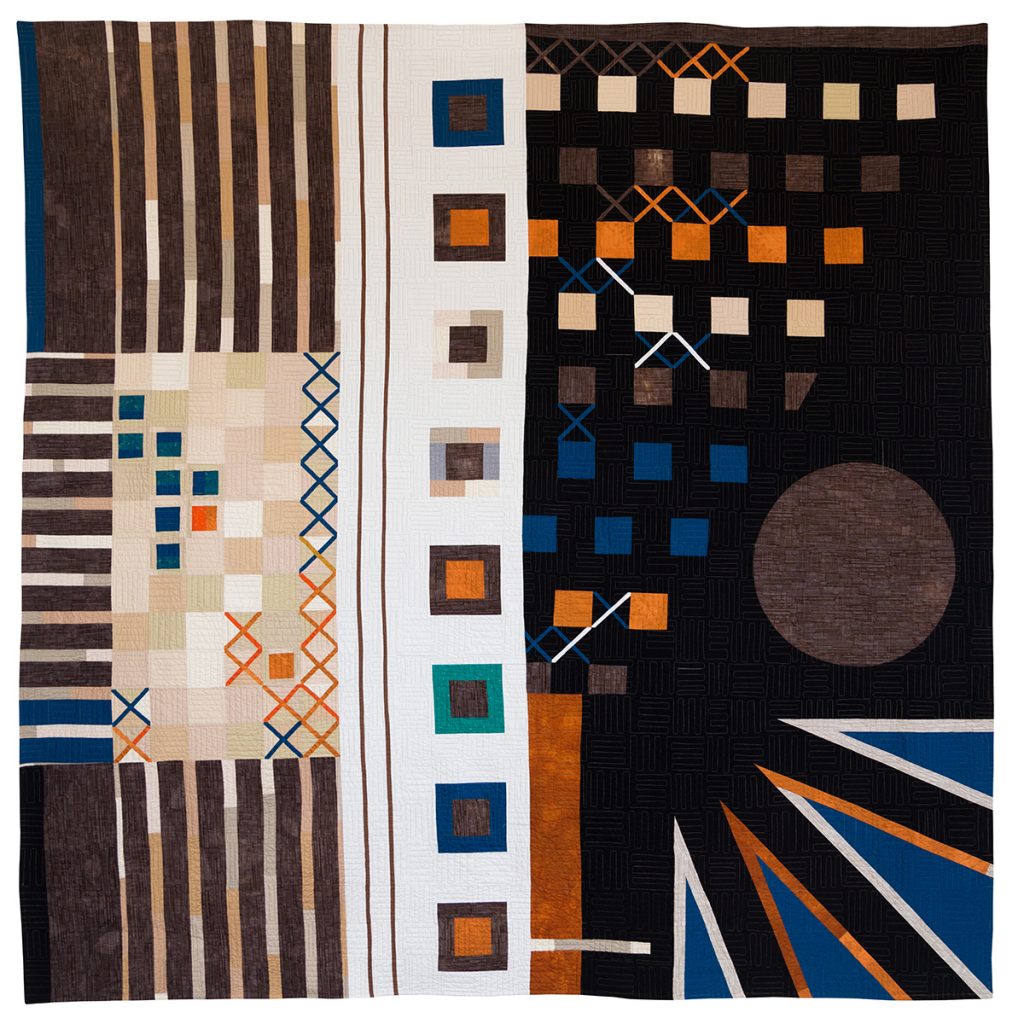
Bring it Home. Image courtesy of Kim Eichler-Messmer.
Do you consider yourself a “quilter”, an artist, or some combination of both?
I think of myself as an artist because making art is something I have to do. It’s a way of expressing myself and working through ideas. My medium is often quilting, but not always. I also like to dye fabric, screen print, paint, draw, and knit. Sometimes in my art practice I sew things that are like quilts, but don’t fit the classic definition of a quilt. Only using the label “quilter” feels too limiting to me, but I do love making quilts.
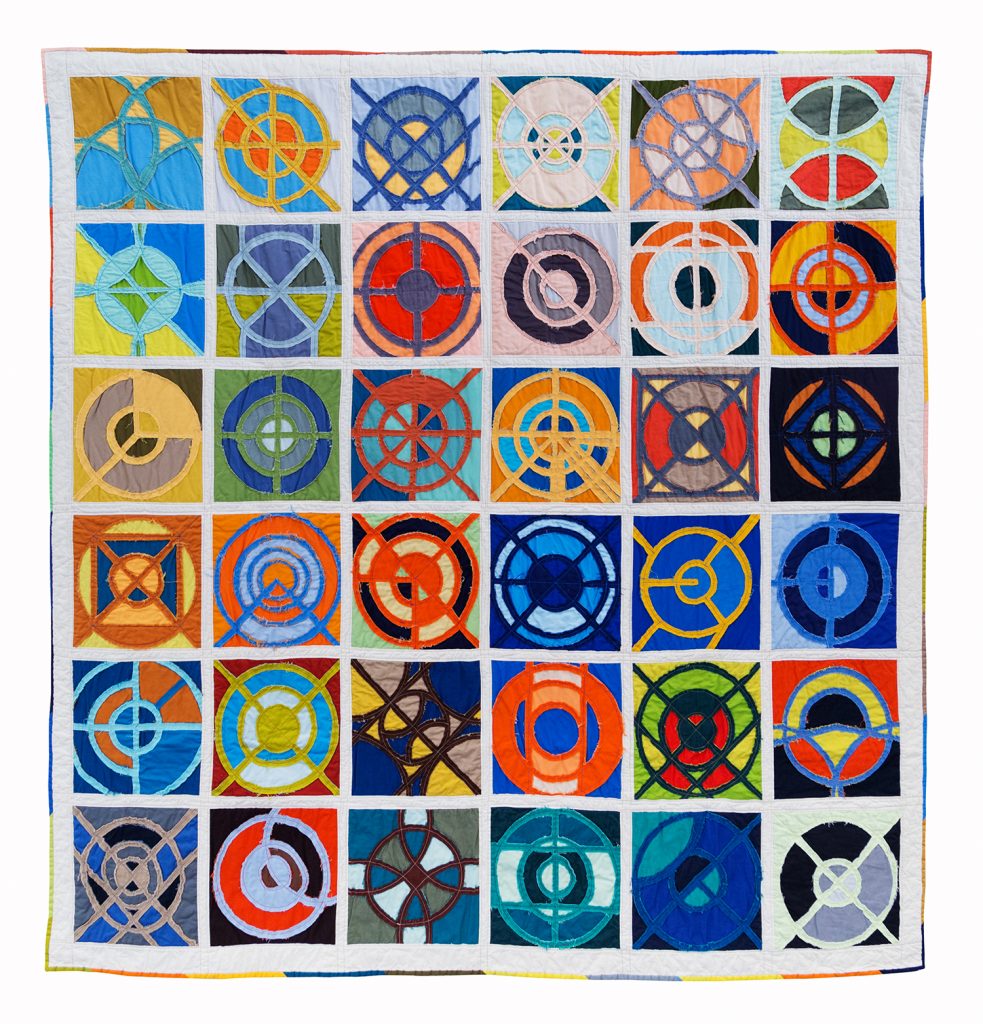
Central Pivot. Image courtesy of Kim Eichler-Messmer.
How would you define “making with intention”?
For me, making with intention means that I have an idea that I want to explore through my creative work and I pursue it seriously. It’s a pretty basic concept for me. It’s about searching for something bigger in the making process than just creating for fun. So I suppose to me, making with intention is the same as making = art. There is nothing wrong with making for fun, I do it all the time. That’s why I knit. When I knit, I follow patterns and make things for myself and for my family that are useful and colorful. I don’t put a lot of thought into it other than “I want a new pair of socks” or “It’s time to start knitting Christmas ornaments again”, or “I want to practice knitting cables”. It’s totally fulfilling to do those things and I’m proud of what I make, but I would never call them art. When I’m making art, I have two goals. The first goal is that I want to make something unique and authentic. That means that whatever I’m making comes from within me. It’s not copying someone else’s work, or following a pattern. The second goal is that I always want to know that I’m pushing myself in some direction. That can mean pushing a dye technique to do something new, playing with piecing to create an interesting composition, exploring a new idea and how to express it, or a combination of all of those. There’s also a third component to making art that is a certain level of reflection and editing is important. There has to be a bar you use to measure your success. It can (and should) be self-imposed, but if you’re not thinking about why something is or isn’t working or if you’ve accomplished a goal, then you’re not growing.
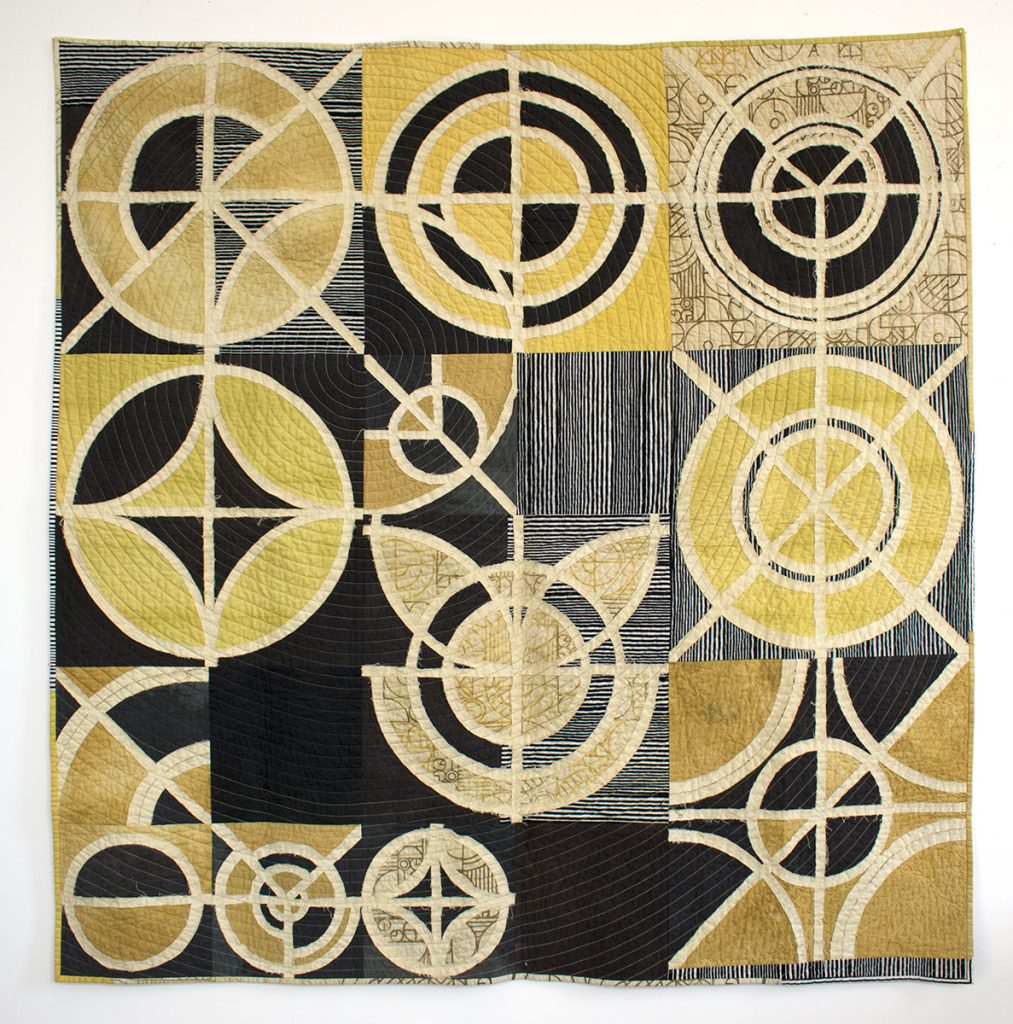
Total Eclipse of the Pivot. Image courtesy of Kim Eichler-Messmer.
Do you think that having a craft makes us more compassionate? If so, then how?
I wish I could say yes, but my honest answer is no. There are a lot of reasons people pursue crafts and there are lots of jerks in the craft world. I think being curious and listening to people makes us more compassionate.
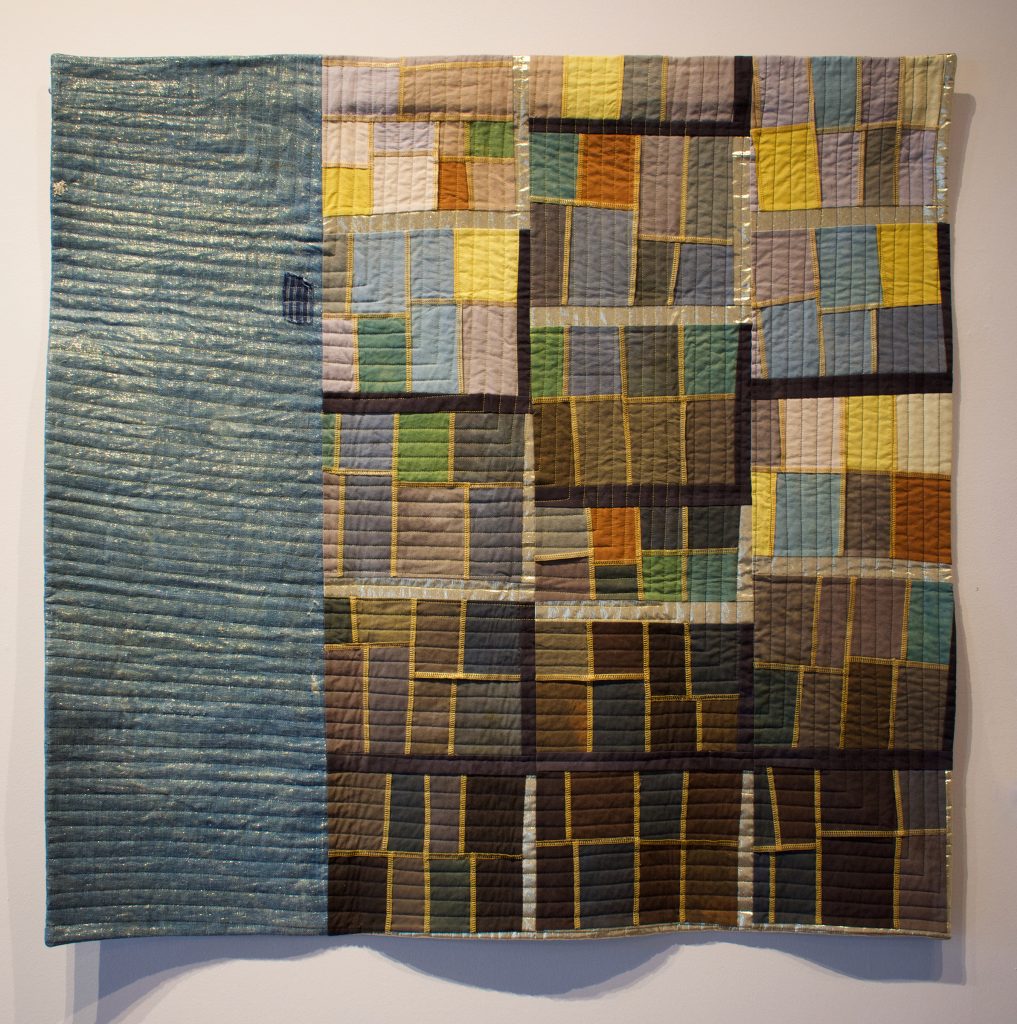
Converge. Image courtesy of Kim Eichler-Messmer.
How does creating feed your soul/spiritual purpose?
Creating is essentially how I think through things. Many of the processes I employ in making my work allow me to enter almost meditative states of mind where ideas can be formed, thoughts can be processed, and problems can be solved. When I look back at things I made a while ago, I can see what was going on in my life or in my mind and how I was working through them in whatever I was making. I often need some distance between when I make something and when I understand what it’s really about because the things I’m working out through the making come out of my subconscious.
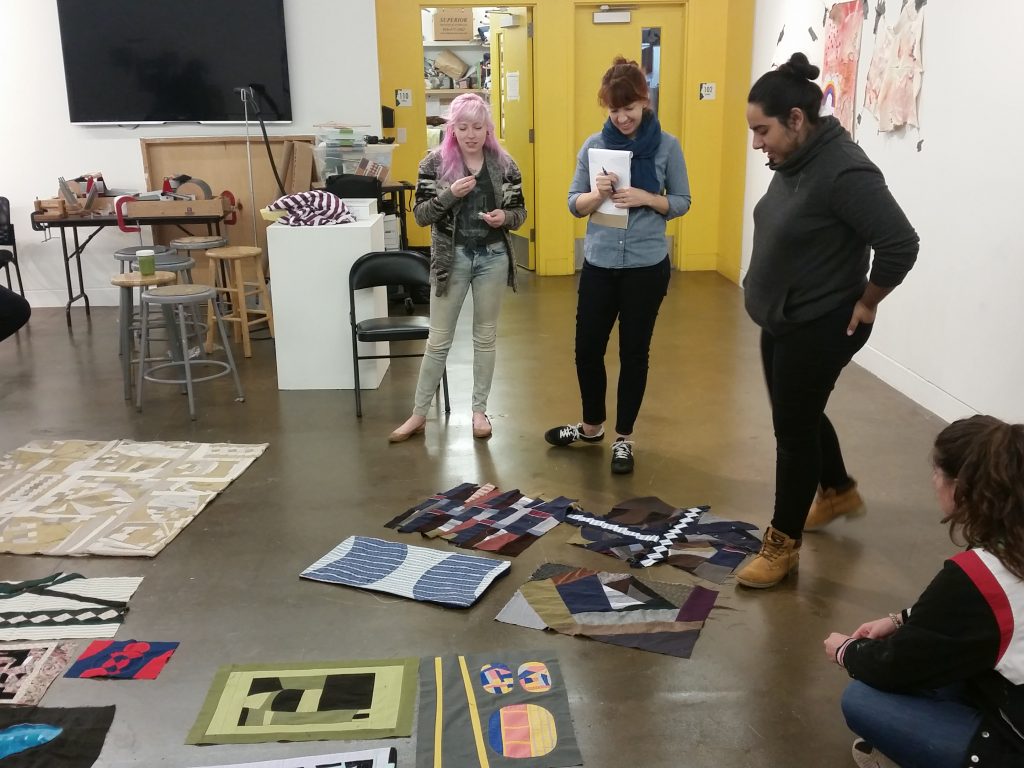
Kim with students during a class critique. Image courtesy of Kim Eichler-Messmer.
Are there any rituals that you perform to prepare/ground yourself in your work?
Making is the ritual. I jump in and get started.
What is the support system you have in place for creating your work?
I have a multi-faceted support system. My husband is delightful and patient and knows how important making art is to me. I share a studio with two great studio mates, Jaime David and Jacquie Gering, who are smart, fun, creative women. We are able to give honest feedback to each other when needed and gentle, kind support when needed. I also have a wonderful job as an Associate Professor of Fiber at the Kansas City Art Institute. I get to teach the things I love (natural dye, screen printing, shibori, quilting) and have really amazing colleagues that I respect, trust, and like as friends. And my students at KCAI are super smart, quirky, creative young adults that make me excited to go to work. As an art professor, art making is seen as part of our job and we are required to pursue it seriously. So that also helps immensely.
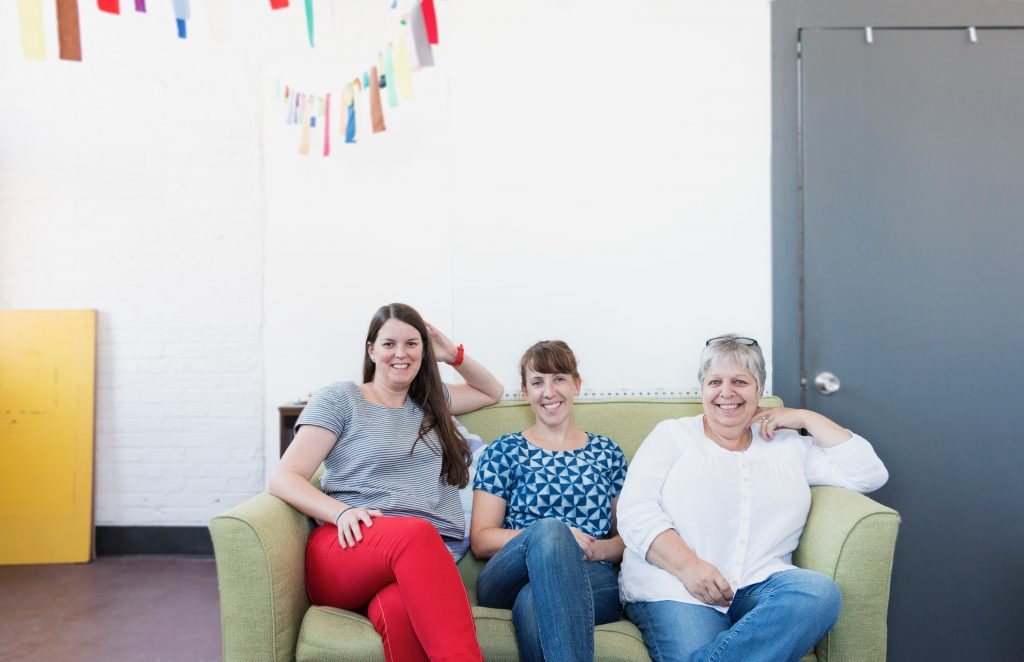
Kim (center) with Jaime and Jacquie. Image courtesy of Kim Eichler-Messmer.
How do you deal with comparison to / envy of others? Can you describe a time when you used comparison/envy/admiration to push yourself in your own work and self-discovery?
Ugh. Comparison/envy is the worst. It’s so hard not to see what other people are doing and feel bad or guilty about what I’m doing (or not doing). Every time I feel myself starting to get jealous of someone, I try to redirect it into being happy for that person and realizing that they earned that success and it has nothing to do with me. So many times I have found myself being envious of someone else and trying to do what they do, whether it’s designing fabric, having a show somewhere specific, teaching somewhere, etc. and realized in doing so that the thing I was trying to do wasn’t right for me in the first place.
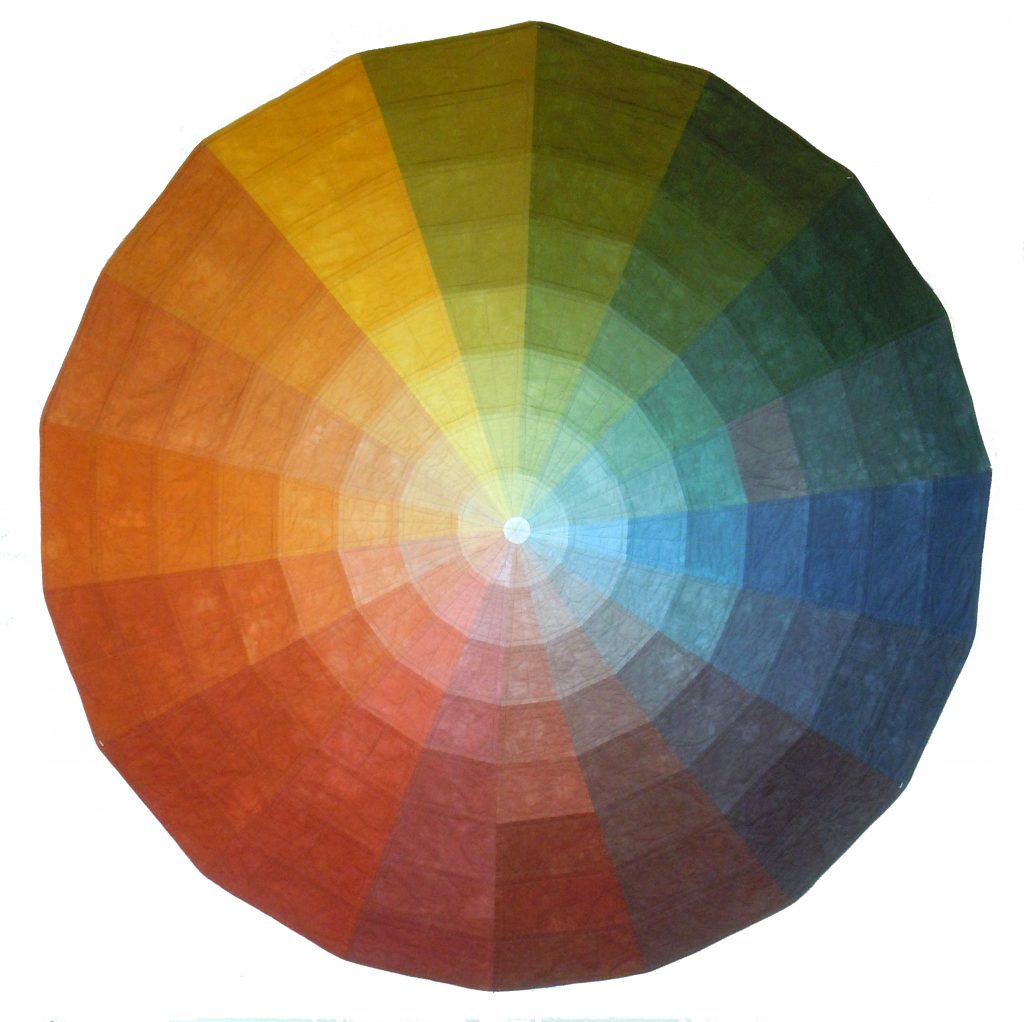
Color Wheel. Image courtesy of Kim Eichler-Messmer.
What was the most challenging thing you ever made?
I think every new piece is the most challenging. Problem solving and trying new things are part of the fun for me and I feel like if I’m not challenging myself then I’m standing still. Over the past five years, I have been learning how to use natural dyes. It took me two years of learning on my own by reading books and blogs, then three years of concentrated study after taking workshops with a couple of super smart natural dye experts (Michel Garcia and Catharine Ellis) to finally feel confident with my natural dye skills. I just completed a body of work using the natural dyes. So I think that was a big challenge. Before that, there are a couple of pieces that I’m particularly proud of because they pushed me in big ways. My Color Wheel quilt that has 144 different hand dyed fabrics is one of them. The other is my Barn(Remnant) piece that is all pieced into one large piece of ombre dyed fabric.
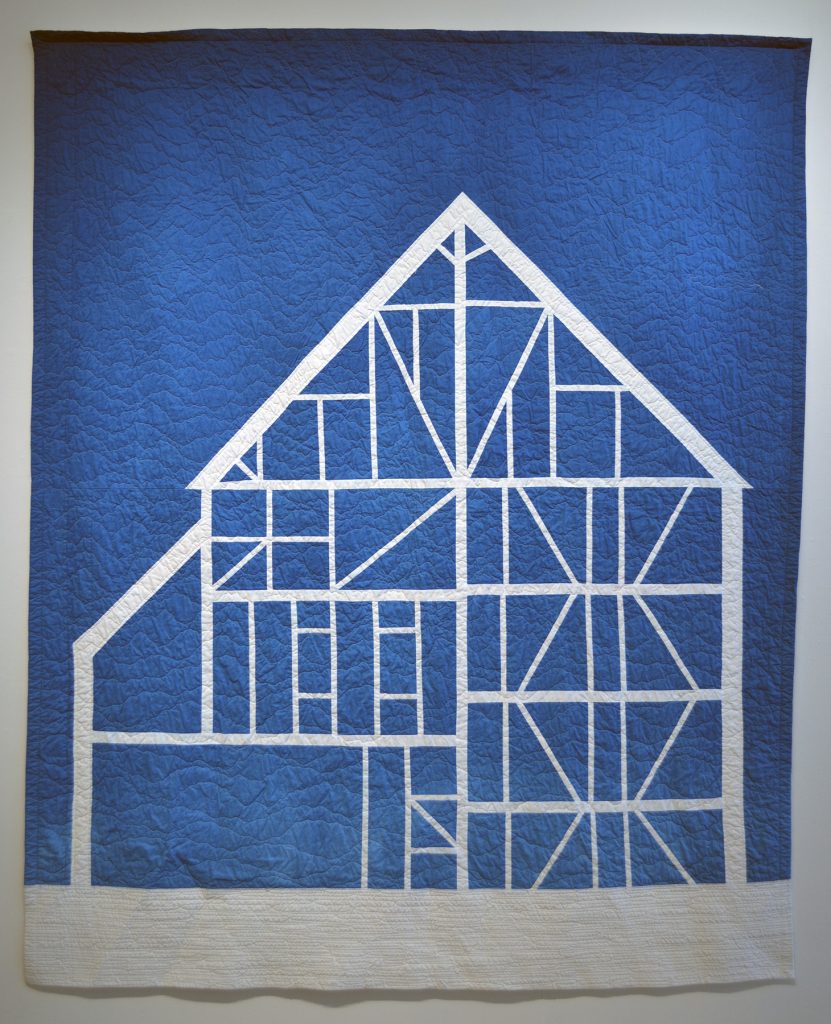
Barn (remnant). Image courtesy of Kim Eichler-Messmer.
What does it mean to you to work in a traditionally domestic medium that historically has been regarded as predominately female (aka “women’s work”)?
When I first started quilting I wasn’t really aware of all of the implications of making quilts and their history. I just knew that I liked dyeing and printing fabric, I liked sewing, and quilting felt sort of like collage. As I have continued to make quilts and try to navigate making quilts in a fine art setting, issues of gender, use, and hierarchy have become more important.
I love being part of the quilt universe. I love thinking about all of the (mostly) women who came before me who made quilts out of necessity, or for fun, or as a form of art, or all three. Understanding the history of quilting in America makes me so grateful to be alive now, at a time when quilts can be considered fine art, and I have the privilege to make them because I want to, not because I have to.
At the same time, it’s frustrating to me that quilts are still so often seen as just functional or decorative and that the artistic talent and vision of the (mostly) women who make/made them is ignored or overlooked as accidental. Most of my work is meant to exist as fine art, not as a quilt that goes on a bed. I pay attention to craft and try to make things as well-crafted as possible, but it’s not part of my practice to make quilts that will be used. Part of the reason I choose to make work that way is that I want people to see quilts in a new context. Quilts are recognizable objects that many people can relate to on a personal level. When one is seen on a wall in a gallery, I hope it allows people to see that they are works of art and are worthy of the same respect and admiration as any other art form. And maybe the people that tell me “my grandma makes quilts” will start to look at their grandma’s quilts with new eyes.
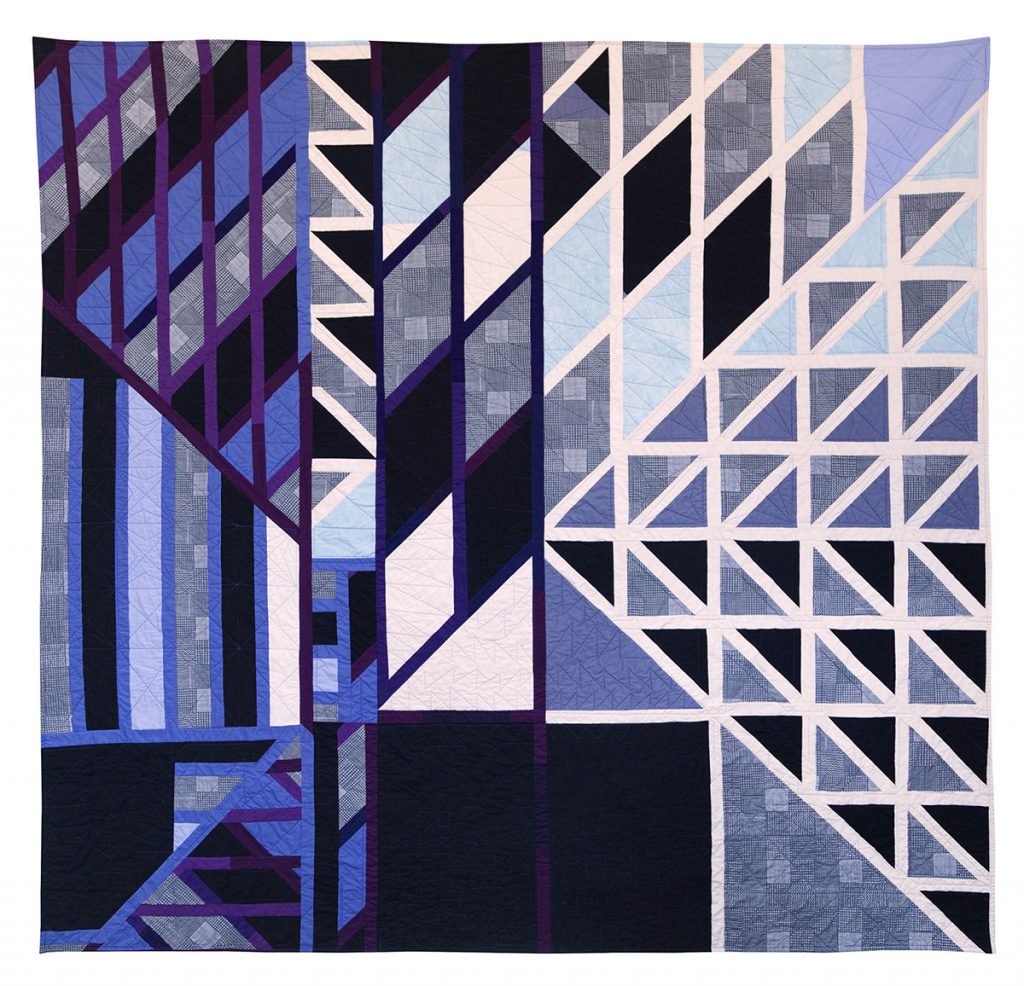
Map of a Place. Image courtesy of Kim Eichler-Messmer.
How do you see your current work in the context of quilting history?
I think I’m part of a wave of quilters who are interested in the craft and tradition but are trying to push the visuals in a more personal aesthetic direction. I use the same materials and techniques that many generations of quilters have used, but I’m also trying to make work that is authentic to me. I hope I’m adding a new viewpoint to the conversation rather than just rehashing what has already happened.
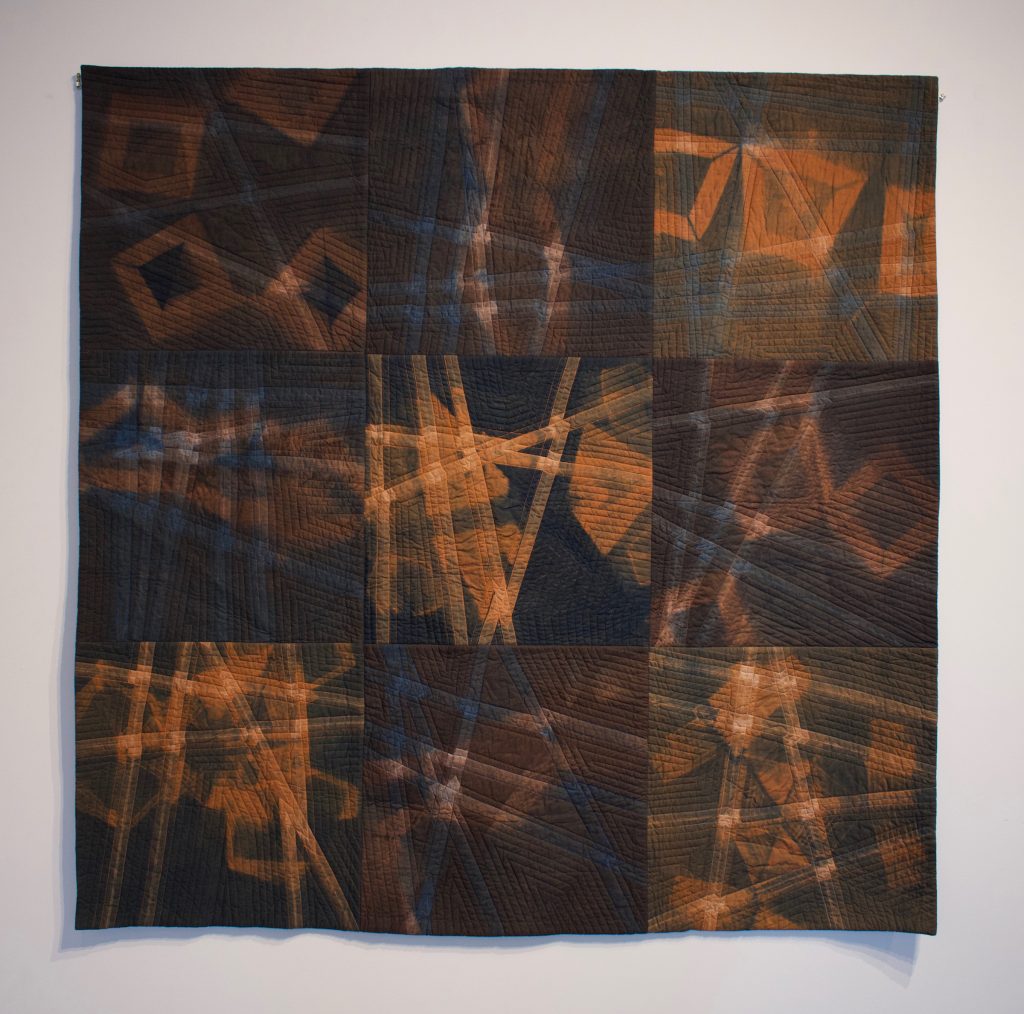
Pathways. Image courtesy of Kim Eichler-Messmer.
Thank you, Kim! Your work is so inspiring and your dying techniques are so rich with pattern and texture! For more about Kim, or to find out more about her classes and workshops, visit her website. Also, connect with her on Instagram, Facebook or Pinterest.
Want to participate in the Creativity Project? You can do that! Click here to take the survey!
The Creativity Project can be found on Instagram, Pinterest, Twitter or Bloglovin’. Or check back here every Friday of 2018!

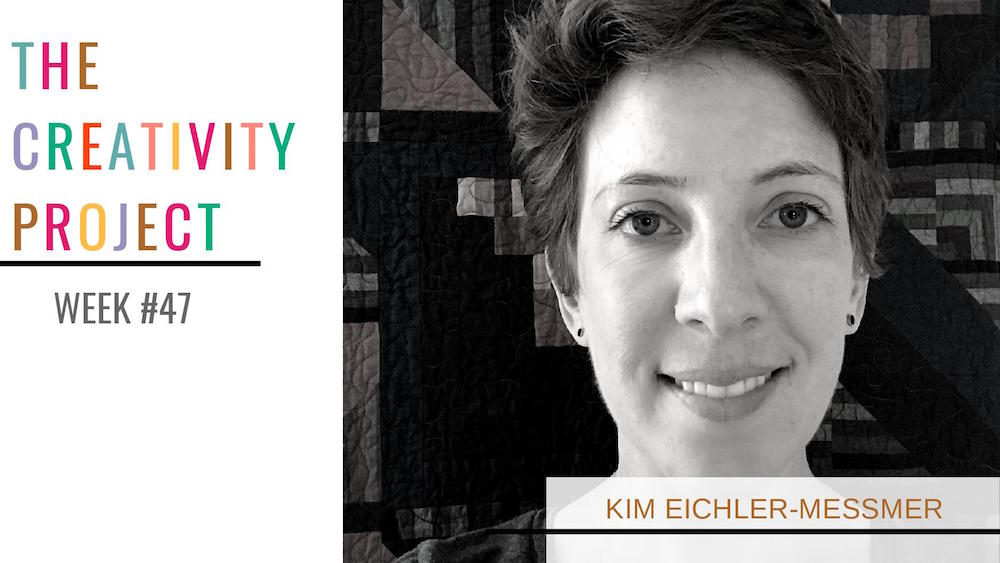
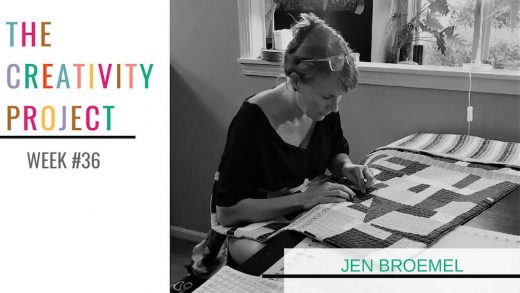
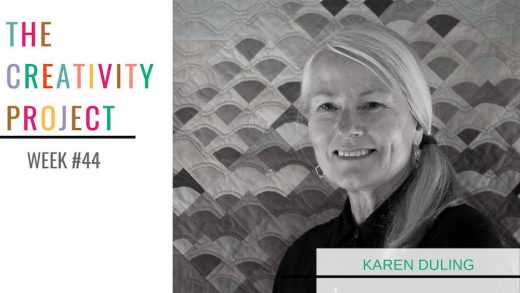
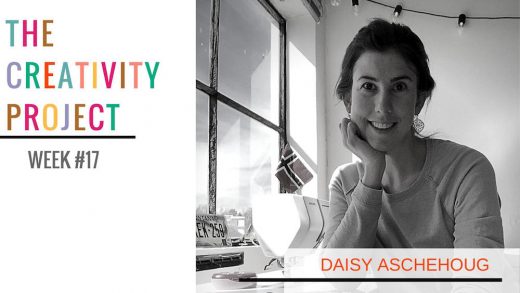

Leslie Tucker Jenison
December 2, 2018 at 12:16 amKim, I am a great admirer of your work and what it means to you. I can relate to so many of your comments. Thank you! I enjoyed this post very much.
lelandavestudios@gmail.com
December 4, 2018 at 1:23 pmThank you Leslie! I so agree – Kim’s interview had a lot of really interesting and insightful thoughts. Well worth the read!